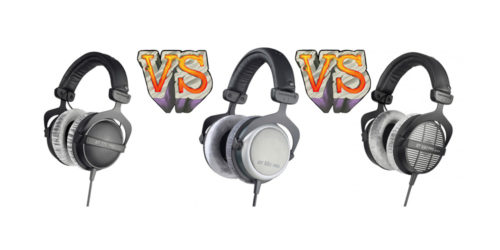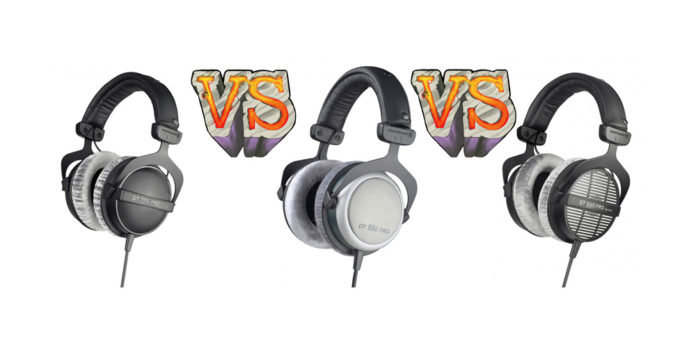Continuing our recent spate of comparison reviews, today I’m tackling three oft-confusing headphones from Beyerdynamic: DT770, DT880, and DT990. Priced at $169, $199, and $179 respectively, these headphones all have a tendency to bewilder prospective buyers. Add to this the murky model numbers, and you’ve got a recipe for confusion. But how do these headphones stack up against one another? And which one is right for you?

The three models in question all utilize equal amounts of plastic and aluminum. Thick, plush pleather padding covers the lightweight headband. Velour padding comes standard on the earcups, although pleather variants may be purchased separately.
Perhaps the most visible difference between these headphones, though, is the earcup design. The 770 features a closed-back design, while the 880 and 990 offer semi-open and open-back designs, respectively.
All three models sport a 9.8 ft (3 m) coiled cable and include a drawstring pouch for transport. A hallmark of Beyerdynamic design, these headphones can also be dis-assembled and every part can be individually serviced.
Specs
DT770 Specs
Frequency Response: 5-35,000 Hz
Nominal Impedance: 32, 80, or 250 ohms
Sound Pressure Level (SPL): 96 dB
Total Harmonic Distortion (THD): NA
DT880 Specs
Frequency Response: 5-35,000 Hz
Nominal Impedance: 250 ohms
Sound Pressure Level (SPL): 96 dB
Total Harmonic Distortion (THD): NA
DT990 Specs
Frequency Response: 5-35,000 Hz
Nominal Impedance: 250 ohms
Sound Pressure Level (SPL): 96 dB
Total Harmonic Distortion (THD): NA
As we can see from these specs, these headphones have a frequency range of 5-35,000. While the 770 offers options for 32-, 80-, and 250-ohm options, the 880 and 990 are offered with 250 ohms. For portable use, the 770 is the optimal choice, while the other two models will benefit from some moderate amplification. Sound pressure level on all three models is 96 decibels – not too shabby, and pretty much par-for-the-course where semi-open and open-back designs are concerned. Finally, Beyerdynamic doesn’t volunteer any info regarding Total Harmonic Distortion, but I’d hazard a guess that it’s as low as <0.3%, or even <0.2%.
Low End
The 770 and 880 offer more in terms of bass and low end detail, while the 990 has a more relaxed and understated low end. Between the three models, the 770 sports the most bass impact, with detail playing second fiddle. The 880 seems to even this playing field, offering a similar level of bass, but more detail to boot (thanks to the semi-open design).
Mids
For midrange detail and clarity, the 880 and 990 pretty much take the cake, but the 770 is no real dud here, either. While the closed-back design and dynamic nature of the 770 can seem to sandwich the midrange, there’s still enough detail to recommend this headphone for some serious studio action. Really, though, the semi-open and open-back designs lend a greater air of separation to those same mids – heightening the impression of detail.
High End
Here the 990 really excels – pulling ahead of both the 770 and 880. While somewhat bright, the highs are incredibly detailed without becoming piercing or uncomfortable. In comparison, both the 770 and the 880 sport a less intense high end with a more subdued sound. If forced to rank the three models in terms of high-end detail, I’d put the 770 at second place – but just barely. The 880, in contrast, seems even more relaxed and subdued than the 770.
Soundstage
This is pretty much a no-brainer, but soundstage remains most present in the 990 (due to the open-back design). The DT880 comes in second here, with the semi-open design offering a good sense of space and definition, while allowing the headphones to retain a little extra oomph in the lows. While not a total bust in terms of depth or placement, the 770 still finishes last with an immersive sound that just doesn’t impress as much as that of the other two models.
Recommendations
For those seeking a fairly balanced studio monitor, the staple sound of the 770 beats all. It will also be at home in the studio or on the go. Bass is present, if a little intense at times, but this works well in conjunction with the slightly bright high end.
Bass junkies could easily consider between the 770 or the 880, though I’d still recommend the 880 – especially if detail is a secondary concern. Also, due to the semi-open design of the 880, bleed and isolation aren’t so bad – more than adequate for regular home use with minimal ambient noise.
Where attention to mids and highs is sought, the DT990 distinguishes itself as the obvious choice. Fans of classical music will rejoice at the revealing nature of this headphone, while simultaneously enjoying the spacious and immersive soundstage.
Final Analysis
Long story short, the DT770 is a closed-back studio model that does everything okay, while offering a little more “oomph” in the bass. The DT880 lessens some of that oomph, while also providing a little more detail and a slightly more relaxed high end. And the DT990 offers more attention to detail in the mids and highs, while possibly skimping on bass. Each model fills a specific niche, hinging on the legendary German engineering that Beyerdynamic is known for.
You can order the pro versions here
BEYERDYNAMIC DT 880 PREMIUM EDITION
BEYERDYNAMIC DT 990 PREMIUM EDITION
MAJORHIFI may get a commission from retail offers.
Compare the ranking of various headphones, earbuds and in-ear monitors using our tools.
Discuss this, and much more, over on our forum.
---MAJORHIFI may receive commissions from retail offers.















